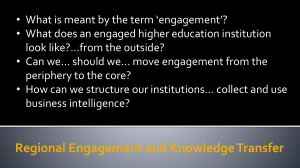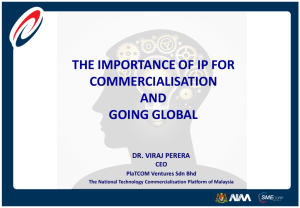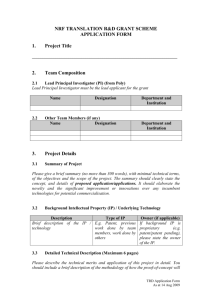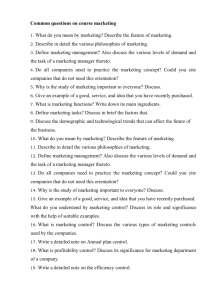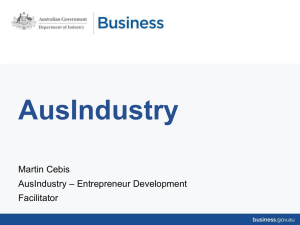Technology Innovation Presentation
advertisement
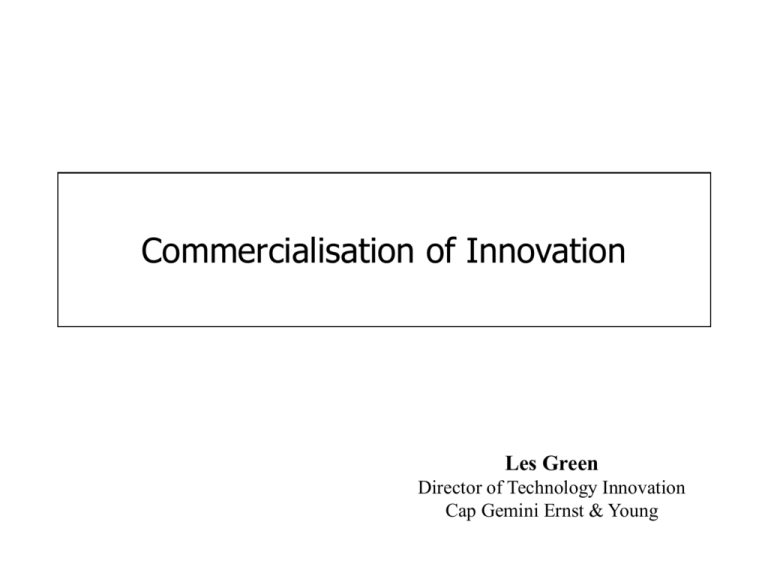
Commercialisation of Innovation Les Green Director of Technology Innovation Cap Gemini Ernst & Young Define Innovation • Likely to be completely new product or service • Could also be a small improvement in existing products or services • Might be an improvement in internal processes too • Today is likely to have a strong technological component, e.g. software, electronics • Probably for existing market, but may also create new / niche Importance of Innovation • • • • • Increases opportunity market separation Good for the economy as a whole (as companies trade on a global basis) Usually leads to cost reductions – better margins Should give consumers greater satisfaction and wider choice Reduces dependency on old products / services and technological processes. What are the stages of Innovation? • Creative idea, spark of genius! • Creation of white papers, reports and reviews • Proof of Concept(s) • The business plan, financial case and the MONEY!!! •The commercialisation process begins in earnest The four P’s Commercialisation Successful Innovation needs Purpose • • • • • Must give the creator either a “build” and/or “deliver” opportunity Should generate revenues within a year (from Stage 0) Investment (through Proof of Concept) must within budget Revenues for first year should be “known” with set margins Revenues/margin projections and the R&D plans for first three years should be well documented • Need to take account (amortise) of the the process costs of Innovation over the life of the product • Should pre-build features into the product – but not always release all of these in first version • Understand the customer segmentation of the target markets from the outset. What about Promotion? • • • • • The need to influence consumer behaviour Creating the “MUST HAVE” factor Separation from the competition Making the Innovation seem worthwhile / valuable Built-in adaptive qualities to stay ahead. EXAMPLE: SONY Walkman (1979) had features ready for release to fight competition. Reduced size, Radio (FM), Auto Reverse, Shock Resistance, Water Resistance Rechargeable batteries, Alarm Clock, Dolby …… and even smaller size! People didn’t NEED these features, SONY made them “Desirable”. And the Process? GATE 1 Stage 0 First Pass Possible Idea AActive 1 month CKilled / redirected Stage 1 Investigation 1 - 2 months • 1st pass business case • Build high-level business case (2-3 • Does it fit with main page text) plus panel Purpose? set (max 10 slides) • Can we find suitable technology partners? • Discuss with technology and • Do we understand this market segment? financial partners • Agree HOA / MOU • Who will fund this? between partners • Good opportunity but no suitable Btechnology or Pending financial partner • Other activities putting this on back burner • Resource constraints • Outside main Purpose • Not interested at this time GATE 3 GATE 2 • Further information needed for business case • Technology or financial partners not ready to proceed just yet • Other resource constraints • Business case not strong enough • Unable to agree HOA / MOU Stage 2 Pilot / Proof of Concept (Product/Concept/Commercial Development) 2 - 3 months • Agree main deliverables from pilot e.g. panel sets, business plans and demonstration system etc. and set a budget cost for exercise • Build a team of: Executive Sponsor, Programme Director, Subject Matter Expert, Project Manager, Technical Staff (developers, business/technical analysts) • Implement a Project Office to manage process • Hold weekly meetings to review progress against plans • Prepare monthly financial reports against budget • Build demo system including key features of solution • Determine likely problem areas for full system and consider which products/partners might overcome these • Identify early adopter clients and sign SOPs • Find industry partners that can provide data feeds / support the new solution • Prepare outline marketing material and slide deck (10 max), give internal briefings to interested groups • Review competitive products (pricing, market share, features) and determine salient separation messages • Build a flexible financial model (best/worst cases) • Build a Lexicon/Glossary of industry terms • Hold briefings with important industry figures to discuss / challenge the new solution – use CGE&Y Account Directors or trade organisations for access • Prepare final legal documents with partners for new venture • Take GO/NO-GO decision with Executive => Go to A or C (B not appropriate) GATE 4 Stage 3 Build Solution 3 - 9 months • Run ASE/RSW with all parts of the value chain • Use output for Inception phase of RUP • Agree all deliverables from build phase and set a budgets for whole project • Develop the solution in conjunction with main technology partners • Consider the financial aspects of off-shore resources • Prepare documentation on how service will be supported and implemented (AM/FM) • If hosting included, agree pricing for service • Finalise the roll-out plan – starting with early adopters and then fully. Consider issues affecting UK, Europe, global roll-out • Begin building marketing campaign – events, press releases, brochures, seminars, launch party. Include internal briefings • Keep Executive abreast of progress every month but agree scope changes with them immediately • Move early adopter SOPs to legal agreements • Update the Lexicon/Glossary of industry terms • Continue briefings with important industry figures to discuss progress of the project – promote awareness • Prepare final legal documents for customers / suppliers for new venture • LAUNCH solution Keeping the Pipeline fresh • Measure number of new ideas generated per period (internal and external) • Monitor quality of the ideas generated (should get harder to make decisions) • Where are the ideas coming from in the organisation and externally • Is the Process keeping abreast of the Pipeline? Commercialisation of Innovation – Summary for • Aim to create a small number of “market making” opportunities every year (business process) • Sourcing great new technology to integrate with Alliance partners (business products) • Evangelise our credentials!! Commercialisation “Working with clients and partners to create the ‘Must Have’ solutions of tomorrow” Commercialisation of Innovation Questions …. Les Green Director of Technology Innovation Cap Gemini Ernst & Young
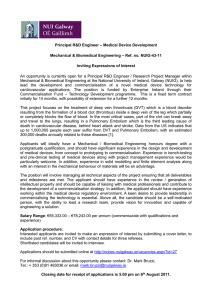
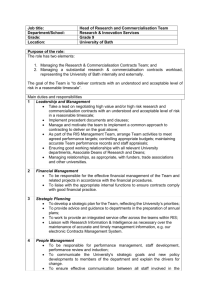
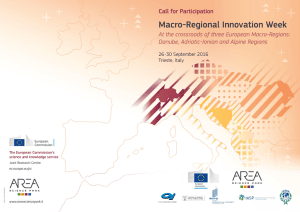
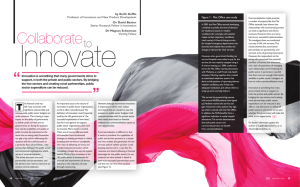
![Intellectual Property Advisor [AGREED] - Heriot](http://s3.studylib.net/store/data/007874931_2-6e73d6be289ab90d6b3ba9f98f61067d-300x300.png)
